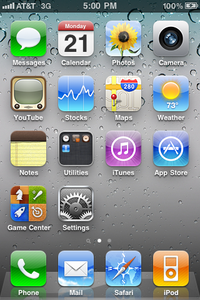iOS (known as iPhone OS prior to June 2010) is Apple's mobile operating system. Originally developed for the iPhone, it has since been extended to support other Apple devices such as the iPod touch, iPad and Apple TV. Apple does not license iOS for installation on third-party hardware.
iOS is derived from Mac OS X, with which it shares the Darwin foundation, and is therefore a Unix-like operating system by nature.'
In iOS, there are four abstraction layers: the Core OS layer, the Core Services layer, the Media layer, and the Cocoa Touch layer. The operating system uses roughly 500 megabytes of the device's storage, varying for each model.[4]
Version 4 (iOS4), announced in April 2010, introduced multitasking, threaded email, and several business-oriented features.
Multitasking
Before iOS 4, multitasking was limited to a selection of the applications Apple included on the devices.[28] Apple worried that running multiple third-party applications simultaneously would drain batteries too quickly. Starting with iOS 4, on 3rd-generation and newer iOS devices, multitasking is supported through seven background APIs:[29]
- Background audio
- Voice over IP
- Background location
- Push notifications
- Local notifications
- Task finishing
- Fast app switching
[edit]Switching applications
Double-pressing the home button activates the application switcher. A scrollable dock-like interface appears from the bottom, moving the contents of the screen up. Choosing an icon switches to an application. To the far left are icons which function as music controls, and a rotation lock. Holding the icons briefly makes them wiggle (similarly to the homescreen) and allows the user to quit the applications.

No comments:
Post a Comment